Little Richard died Saturday. He instinctively figured in my review of Martin Aston’s Breaking Down the Walls of Heartache: How Music Came Out:
Continue reading “Penniman, Shelley and Lee”Symonds, Whitman, Rossetti and Rake
Before Christmas I checked out a book from my little public library branch: Naomi Wolf’s Outrages: Sex, Censorship, and the Criminalization of Love. I had a lot of other things to read and left it for last, not knowing what it contained, vaguely recognizing the author’s name. Turning to it, I recognized Wolf’s photo. If nothing else, readers might remember her defense of Julian Assange when he was accused of sex crimes in Sweden. I thought the book would be a history of censorship, but it’s more comprehensive. By introducing and then returning often to her cast of characters, Wolf creates an intimate narrative against the mise en scène of her historical sweep and sociopolitical stance.
Continue reading “Symonds, Whitman, Rossetti and Rake”Falling Awake: Joseph Shuldiner (1957–2019)
Yesterday my friend and collaborator Rob Berg messaged me that my old, dear friend Joseph Shuldiner died. Of a brain tumor. It’s a cruel joke: I’m the one bingeing on cheddar cheese, and last week I was told to go on statins.
My heart goes out to his spouse Bruce Schwartz, his sister Judy, and to all he’s touched.
Joseph and I go a long way back, but hadn’t corresponded for several years. Looking for a photograph last night I came upon a half-dozen file folders containing the following mementos.
Continue reading “Falling Awake: Joseph Shuldiner (1957–2019)”The Summer of Our Discontent
The same edition of Gay & Lesbian Review that I touched on last time—its Stonewall Special—contains an essay by author and publisher John Lauritsen: “The Rise and Fall of the GLF.”1 I reread the piece last month.
Shortly after Stonewall in the summer of ’69 Lauritsen attended a meeting of gay people who were debating whether to align with the antiwar movement, with which John had been involved since 1965. He and the other radicals at the meeting carried the day and so the group eventually was dubbed Gay Liberation Front, a nod to the National Liberation Front—aka Viet Cong—of Vietnam. This is an example of the overlap I always saw as perfectly natural. As a kid I organized against the war in high school and and also wrote a book report on James Baldwin’s Another Country.2 Others might have preferred cubbyholes over connections.
nAIDSayer
I first became acquainted with John Lauritsen’s writing through the pages of the New York Native, a gay biweekly founded by Charles Ortleb, publisher of Christopher Street magazine. I’d been picking it up in L.A. and later subscribing because of its stories critical of the medical establishment’s stance on HIV and AIDS. (Only later would I read that the Native published the first article in the popular press about AIDS, in 1981.3) The Native’s Wikipedia entry features an image of the biweekly’s cover of June 1, 1987, quoting Lauritsen’s critique of AZT. Besides Lauritsen I’d been reading other AIDS renegades like scientist Peter Duesberg, who questioned the role of retroviruses in cancer and AIDS and whom John was the first to interview. (Read about John’s many writings on the subject here.)
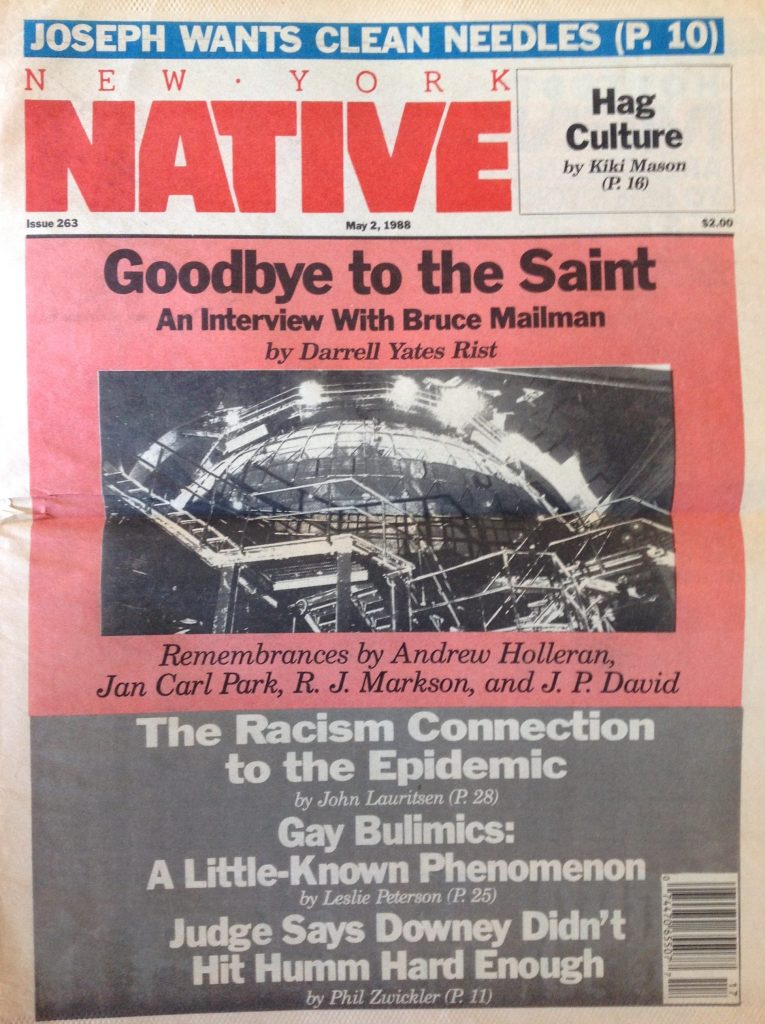
Gay Liberation’s 150th Anniversary
More recently I’ve consulted Lauritsen’s book The Early Homosexual Rights Movement (1864–1935) coauthored with David Thorstad.4
The authors begin by observing that
the Stonewall riots represent not the beginning of gay liberation but the beginning of a new wave of gay liberation. 1969 marks a rebirth, an anniversary—indeed, one might say the 100th anniversary of gay liberation.5
And the authors describe yet another historical overlap—in their chapter Socialism and the Early Gay Movement. It’s a good introduction to an under-appreciated period in the struggle for liberation(s).
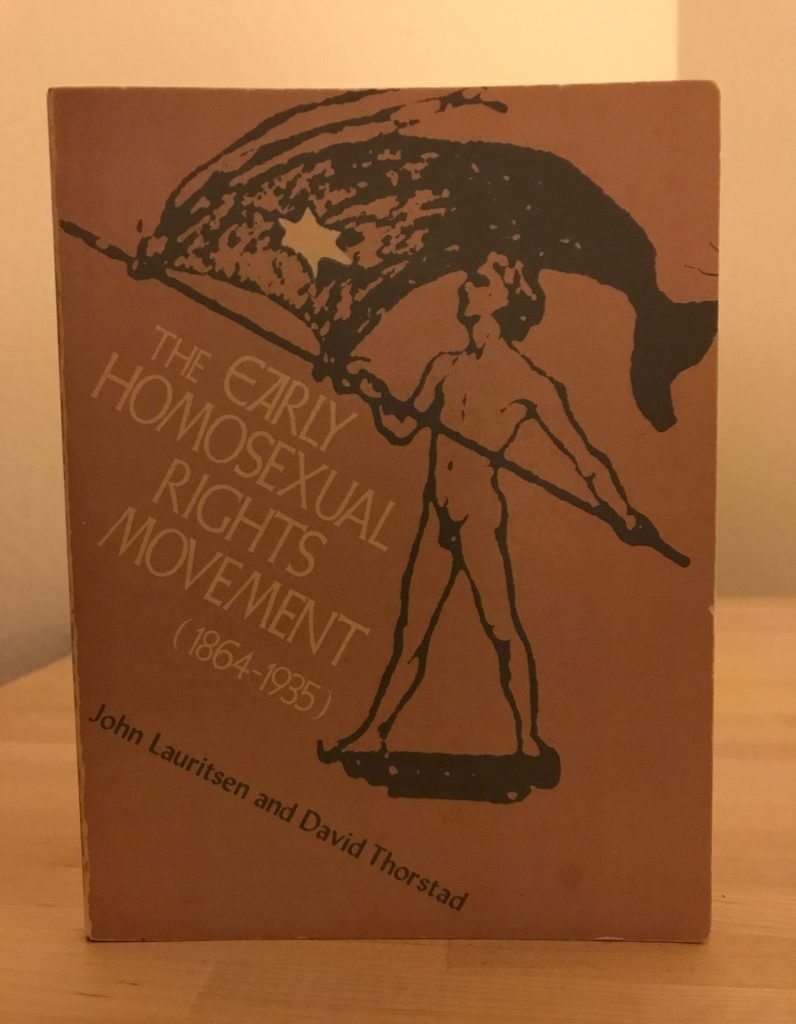
Versus the Voice
On my second reading of Lauritsen’s essay about GLF I took note of what he calls the group’s “first major demonstration.” It was a picket line—not against, say, The New York Times, which forbade the word “gay” until 19876—but against The Village Voice. I was astounded. I’d subscribed to the Voice in the ’80s in order to stay on top of music trends, and I found it to be extremely gay friendly. What a difference a decade makes. And I suspected I might know why GLF had targeted the Voice.
In a footnote to my previous post, Vaniegem and Bubblegum, I mention that one of the two reporters in the Voice’s immediate coverage of Stonewall, Lucian K. Truscott IV, wrote this past February about another, earlier subject: being groped by Cardinal Spellman while trying to interview him for the West Point cadet magazine The Pointer. I kinda forgot about that until rereading Lauritsen, who writes that the GLF picket line was incited in part by the Voice‘s “antigay article about Stonewall.” I wondered if Truscott might have been the author. Fortunately, Google now archives publicly the Voice’s run of 999 editions between 1954 and 2004 (with many holes).
The initial riot reporting is riveting, regardless of subsequent scrutiny. Truscott was joined on the front page of the July 3, 1969 issue by columnist Howard Smith. Truscott—a newly minted West Point grad waiting to report to Fort Benning—was well read enough to compare the first night of Stonewall to a William Burroughs novel. And a “fairy tale.” Apart from the usual mention of limp wrists as well as Truscott’s martial “forces of faggotry” and “gay brigade” the piece is relatively straightforward. As is Smith’s; he actually followed the police into the Stonewall Inn while they waited for reinforcements. Could either of these be the anti-gay story that caused the GLF to picket?
Since I’d corresponded with John Lauritsen in 2012 about an unrelated matter I didn’t hesitate to ask him about this last month. No, the article was penned by Walter Troy Spencer in the July 10 edition of The Village Voice.
Spencer begins that installment of his occasional Last Call column, titled “Too Much My Dear,” with what NBC News in June (2019) called “coincidence” rather than “cause and effect.” And it’s been quoted often, even if Spencer’s source is all but forgotten:
The combination of a full moon and Judy Garland’s funeral was too much for them, Dick Neuweiler said the other day, assessing the cause of the Great Faggot Rebellion.
Spencer strings a strand of tedious complaints lodged over the years anytime people rise up: the inconvenience, the injury to themselves and their businesses, the cops being such great guys (with a sense of humor) and, as Spencer puts it, the “ugliness on both sides.”
Still, why the GLF ire? Reading Spencer today he seems typical of the time. Except that it was The Village Voice. And except that the other motive for GLF’s picket line, explained by Lauritsen in his essay, is that the Voice “refused ads for [a] GLF dance on the grounds that ‘gay’ was a dirty word.” And except that the second page of Truscott’s July 3 article features an ad, reproduced below—innuendo ignored.
Spoiler alert: The GLF demo “was a resounding success,” as Lauritsen writes in his essay. He recounts this and more in deliberate detail in a GayToday.com story from 2004.
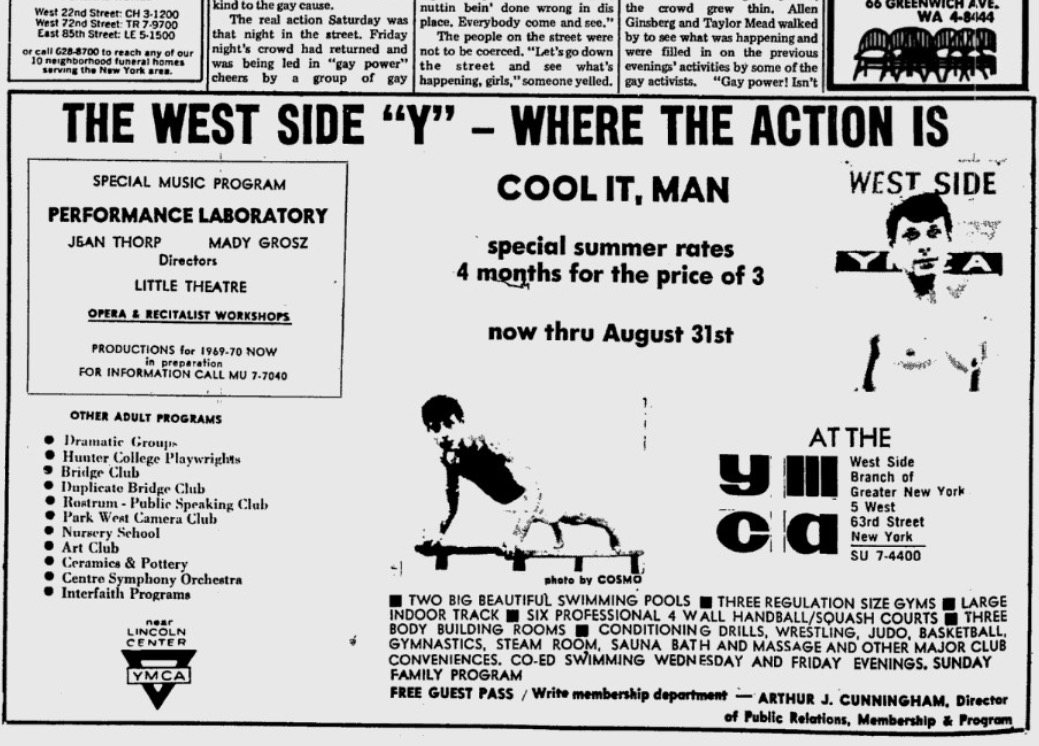
Querying the Q-word
John also sent me a personal reflection on Stonewall’s 50th anniversary in which he argues against adoption of the term “queer.” As he states in the GL&R essay, while the GLF men met night after night to define their aims, they concluded that “gay” should be the preferred term for use by themselves and others—despite any unfamiliarity by the general public. “It was not clinical like ‘homosexual,’ timid like ‘homophile,’ or hateful like ‘queer.’”
Fast forward to a world where “queer” has been embraced from the avenues to academia. One might make a comparison with gay appropriation of the Nazis’ pink triangle a generation ago (not to mention Christians’ embrace of the instrument of crucifixion). But a symbol is not a word, even in this emoji-laden era. I 🔻 You?
The triangle had more than a fifteen-year lead in use and so it seems almost relegated to a bygone era. Not necessarily so for queer. While staffing a booth at the Creating Change conference in 2015 (we offered books from AK Press, an oasis in a desert of NGOs and such) a man older than me came up to the table and remarked that queer to him was a pejorative. Impatient with my inarticulate explanation, a woman younger than me interjected: Suppose I’m a lesbian and have a relationship with a trans* man; gay simply isn’t expressive enough.
Read Lauritsen’s “Stonewall 50 Manifesto: Gay Men Are Not Queers!” and see what you think.
Lauritsen is not alone in his criticism of queer, however, reprinting four other authors’ reflections (and two more of his own). He begins with John Rechy, who himself begins by picking apart the male/female use of the suffixes “-or” and “-ess.” This is a slippier slope than gay/queer because it nearly begins and ends with the terms actor and actress. Rechy writes:
In an excess of purported equality, some Hollywood actresses want to be called “actors.” How sad and self-defeating. Doesn’t opting for the male-designated noun, actor, imply superiority of that male form?
We’re so familiar with these two terms that the switch to which Rechy refers is a jolt (if we hadn’t been paying attention). But why it matters to Rechy—and anyone else—says a lot about how we regard thespians and thespiennes in contrast to those engaged in other pursuits. The feminine suffix -ess is applied to female sculptors but generally not to painters; to female masters but few curators; sometimes to female authors (retaining the “o”) but rarely to operators. To female abbots, adulterers, and even tigers, but rarely to female scholars and tutors and barbers. As a child I recall a neighbor discussing her experience with a negress—but never since. This week, while seeing a dermatologist, I abandoned any impulse to address her as Doctress.
And since I’m nitpicking…. Another of Lauritsen’s reprints, by Arthur Evans, invokes
Ganymede, the beloved of Zeus. In ancient Greek, the word “Ganymede” (Ganumedes) means both cheerful and homosexual, just like our word “gay”. Both words come from a common Indo-European root (ga-).
I realize this supports Evans’s contention that gay and its meanings precede the nineteenth century, but Zeus’s “beloved” often is portrayed as having been abducted. And I realize also: that was then and this is now. But to cite Ganymede in the course of discussing the “insult” of queer is noteworthy because this mythology touches the taboo of pedophilia and, well, kidnapping, trafficking, and servitude if not slavery, even as Ganymede was compensated as celestial cupbearer and made immortal—whether he liked it or not.7
What’s in a name?
Rechy, Evans, Lauritsen, and the two other writers he presents—Wayne R. Dynes and Stephen O. Murray—all remark on the q-word’s mean meanings.
1queer adj [origin unknown] 1 a : differing in some way from what is usual or normal b (1) : ECCENTRIC, UNCONVENTIONAL (2) : mildly insane : TOUCHED c : absorbed or interested to an extreme or unreasonable degree : OBSESSED d : sexually deviate: HOMOSEXUAL 2 a : WORTHLESS, COUNTERFEIT〈~ money〉b : QUESTIONABLE, SUSPICIOUS 3 : not quite well
2queer vt 1 : to spoil the effect or success of〈~ one’s plans〉2 : to put or get into an embarrassing or disadvantageous situation
3queer n : one that is queer; esp : HOMOSEXUAL8
The writers point out that embrace-of-queer disregards the sting of queer-as-invective for older people. Dynes argues: “In the seasoned veteran’s view the newcomer seeks to reinvent the wheel.” Murray’s belief is “that those who despise differences will always be very happy to accord that label to anyone who wants it.” Of course, this is the conundrum of sexual liberation: to be given permission to be different, to revel in difference, to be tolerated in difference, to revolutionize in difference, to homogenize difference….
The arguments collected by Lauritsen are laid out well and the reader can decide on the vigor of their various vintages—Dynes 1995, Murray 1997, Lauritsen 1998 (and 2019), Rechy 2005, Evans 2009. And yet I wondered as I read them why I was unmoved. Coming into a sexual sensibility in the 1960s, I am old enough also to have a sense of queer. Still I can’t recall it ever being used. Fag on the other hand seemed to be the insult of choice. And like Rechy, I can’t imagine an academic discipline coalescing under the designation of “fag theory.” Reimagining gay, just as queer has been, is worth considering, if it’s not too late.
Header image: spread from
The Gay Liberation Book (1973),
ex-University of Vermont Library
Notes
Stonewall, the Great Gay Migration and the Monumental Divide
Last Wednesday I watched a somewhat slimmed-down version of the new documentary Lavender Scare, based on the 2004 (!) book of the same name by David K. Johnson.9 In the film Meryl Streep’s narration explains how the influx of homosexuals from rural to urban regions began in the 1930s, the start of the Great Gay Migration10:
Washington was a boom town. The government was creating thousands of new jobs to combat the Great Depression. Many of the young men and women who came for those jobs were homosexuals. They grabbed the chance to experience a new level of acceptance and friendship in a big city far from home.
I was reminded of a recent essay, “Forget Stonewall,” in the May/June edition of The Gay & Lesbian Review, by Yasmin Nair who reminds readers that the source of that influx still exists.
Continue reading “Stonewall, the Great Gay Migration and the Monumental Divide”I coulda been a bartendah!
—with apologies to Marlon Brando
On the eve of PrideFest here in Denver I thought I’d reminisce by telling about a particular visit to a lesbian bar in the Los Angeles area.
I started hanging out with Judith11 in 1959 or 1960 when we both worked at a North Hollywood manufacturing plant, Borg-Warner, making electronics for aeronautics.12 One night she convinced me to go on a double date and I agreed. But I could tell that my guy wasn’t really into me; he seemed to be interested in her. And Judith’s guy wasn’t really into her, so we swapped partners. (The three of them had gone through school together and at some point the district allowed girls to wear pants. These same two boys—our dates—had been so angry at this change that on the day it went into effect they attended class in dresses.)
After a bad experience with a guy, Judith told me she was swearing off men and she’d occasionally invite me to go with her to lesbian bars. At the time, North Hollywood and Studio City were known for having several that catered to women and to men. Later she (and her son) and I got a two-bedroom apartment together in North Hollywood. Continue reading “I coulda been a bartendah!”
Secrets & Lies & Biden’s Gut Reaction
This post involves a period of U.S. history that’s been dubbed The Lavender Scare. A new documentary film by that name opened yesterday in New York and Los Angeles. Alas, I’m in Denver…
Continue reading “Secrets & Lies & Biden’s Gut Reaction”Careless Whisper: Pansy Patois
In December while trying to verify the colloquialism in The Smiths’ song title “Reel Around the Fountain”13 I noticed that the band’s singer Morrissey had employed a now-abandoned slang in his solo single “Piccadilly Palare,” sung in the character of a former street hustler. It was the lead track on his album Bona Drag, but I hadn’t really collected Morrissey records and skipped that one because it was a compendium of singles. I had, however, collected much Smiths, but I was confused by the band’s many, many compilations and 12-inch vinyl product. In fact “Paint a Vulgar Picture,” from the final album, can be seen as a commentary on this excess, as it laments a pop star’s exploitation in death but also questions the star’s complicity in life.
Satiate the need
slip them into different sleeves!
Buy both, and be deceived
A Perfect Crime?
Yes, this involves Leopold and Loeb and their victim Bobby Franks…
Killing time a week ago in the expansive area devoted to new releases at the central branch of the Denver Public Library, a title beckoned: Nina Barrett’s The Leopold and Loeb Files: An Intimate Look at One of the Most Infamous Crimes, issued last summer.14 If overly familiar with The Crime of the Century—title of Hal Higdon’s 1975 book15—one might ask, Why another rehash?
Barrett has created the sort of case study that resembles an oral history, the kind of approach that I like to take. The book is the logical progression of The Murder that Wouldn’t Die, a 2009 exhibition at Northwestern University, which she curated. As such it is slathered with photos and facsimiles. It reminds me of Exquisite Corpse: Surrealism and the Black Dahlia Murder written by print and exhibition designer Mark Nelson and art and cultural critic Sarah Hudson Bayliss.16 With the look of a university-press popular history, Barrett’s doesn’t have the monograph/fine art sheen of the latter, but both books bring together images that likely hadn’t been seen in one place. And unlike Exquisite Corpse, Barrett breaks no new ground other than by exhuming, well, old ground—hopefully carefully culled.
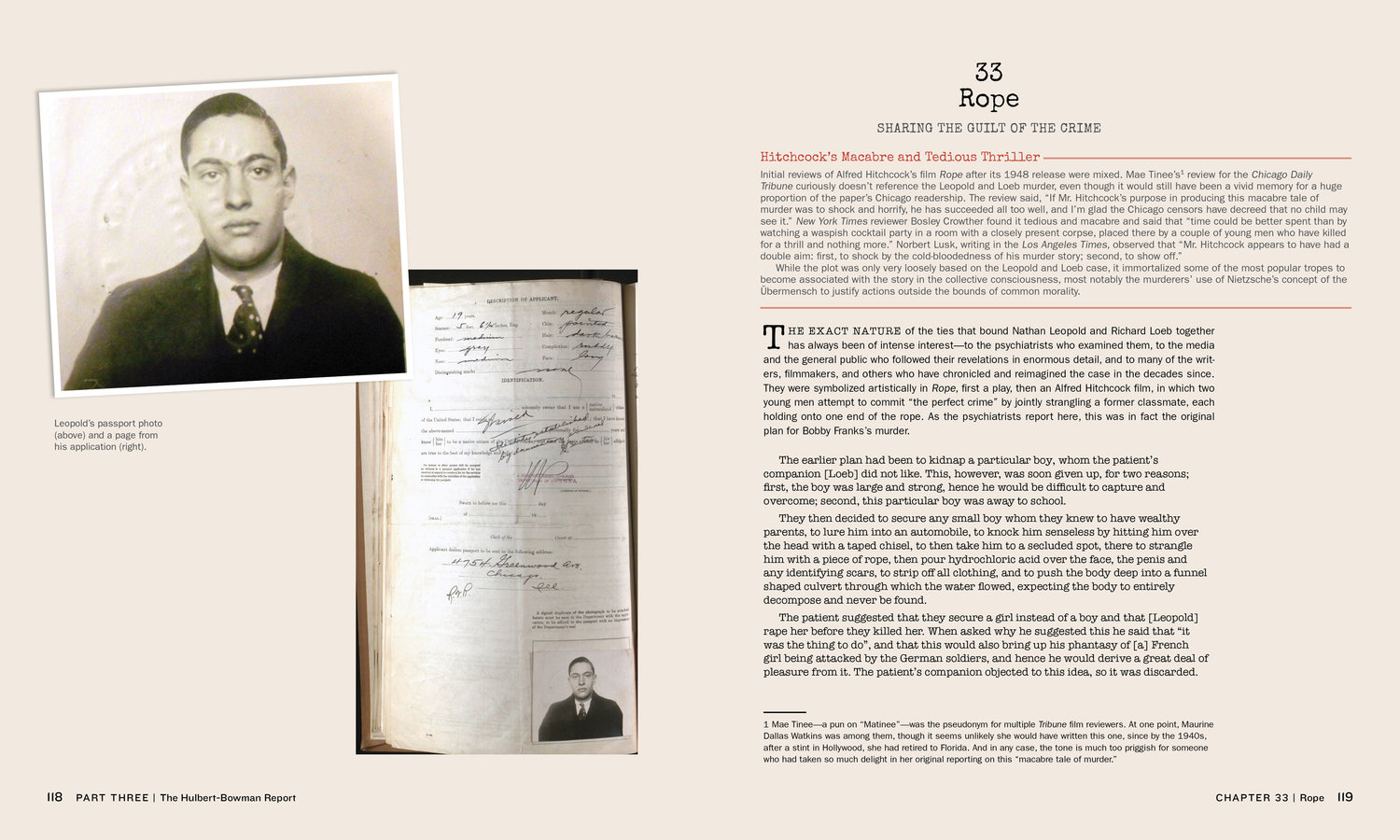
Why discuss a book I haven’t read? I have a list of topics for this blog, some of which, like my most recent post, are the result of nagging questions. One such question involved Leopold and Loeb. Barrett merely induced me to answer it.
Years ago in the pursuit of a larger project I photocopied way too much material from a file on Martin Block, founder and editor of ONE magazine. A passage from a 1993 Block interview, conducted by an unknown party, vexed me. Once I dug into it last week it was relatively easy to investigate. I began with the index of Barrett’s book, which was a bust, but that propelled me. A (virtual) book checkout via Archive.org took me further, but I really needed the Leopold and Loeb trial transcript. Since I’m not an academic I don’t have access. (This is the digital divide that drives me nuts. Even were I a deep-pocketed individual I am denied access.) Fortunately a friend has come through and I can complete this post.
Chicken Pox
chicken (fr naut[ical] chicken = young recruit) pox (k[no]wn L[as]V[egas], mid ’60s) the urge to have sex with younger men.
— Bruce Rodgers, The Queens’ Vernacular: A Gay Lexicon17
Martin Block’s tale actually deserves a context that I wouldn’t mind fleshing out one day, but here begins the slice that I always wanted to delve into.
In the 1930s Block (b. July 27, 1919) had a job as delivery boy for a bookshop with the “most refined customers.”
And it was another kind of world that I had become aware of, and because of my sexual traits and habits, I met on Madison, no on Fifth Avenue one night, a man named Wallace B[misremembered] who I had tremendous, tremendous respect [for]. Wallace had just at that time become an editor at Simon & Schuster. […] Wallace, by the way, was a man you’d find very interesting.
It’s tempting to figure that Block’s interlocutor was archivist Jim Kepner (from whose computer directory the interview was printed). But in my experience, Kepner’s interviews of those he already knew, like Block, were quite informal and conversational, which this is not.
Can I give you a little historical gossip? One of the great gay cases as it was known in this country was the Loeb and Leopold case. Well, […] my friend Wallace, was I think, he was the only or one of the very few witnesses for the defense. And we got to talking about it one day, and […] I asked him about it and I said “What was the true story as you know [it]?” and he said well what never came out was that the reasons that the young [blank line] boy was killed had nothing to do with a thrill killing. It had to do with that this boy at 12 years old or eleven years old was blackmailing Loeb and Leopold and everybody else in their circle because he already was an active homosexual and was blackmailing all the older men, some of whom he had had sex with and some of whom he had not. And he wanted money, and that’s why he was killed.
The question of motive I can’t address except that I’m reminded that a lack of cash led to Loeb’s own death in prison and that Leopold told state’s attorney Robert Crowe that Loeb already “was acquainted with” the fourteen-year-old Bobby Franks prior to his abduction and murder.18 Obviously Wallace B’s account contradicts the usual version of the crime’s narrative, which claims Franks had been selected at random.
I offer Block’s recollection here for any response or rebuttal—not to libel a murdered youth or presume his circumstances.
I mainly wanted to determine the identity of Block’s friend Wallace B, whose surname he misremembered in the interview. Was he even a witness in the trial? With a copy of the witness list I confirmed that a Wallace Brockway testified. And, indeed, this same Wallace B later became an editor at Simon and Schuster, as well as an author, translator, and contributor to many books and audio recordings.
The Fact Hawk
The test of Brockway’s mettle as an editor, according to Block, had been Dick Simon giving him the manuscript of the second volume of Will Durant’s The Story of Civilization, The Life of Greece.19
Brockway found three dozen errors in the first two dozen pages and was hired. “I am grateful to Mr. Wallace Brockway,” Durant wrote in the book’s acknowledgments, “for his scholarly help at every stage of this work.”
On behalf of Simon and Schuster, in 1943 Brockway approached Joseph Campbell to produce a latter-day Bulfinch’s Mythology, which didn’t interest the scholar. Instead—six years later—the house published Campbell’s The Hero with a Thousand Faces.20
Brockway was described as “a fact hawk” and a
sandy-haired, pale-faced, pedantic person […], a young man with an encyclopedic memory and a knack for copying any writer’s style so immaculately that few authors […] were sure what Brockway had rewritten and what [the author] had not.21
At the time of the Leopold and Loeb trial in 1924, according to the transcript, Brockway was an editor “of some books for the Government.” By about 1930 he likely had moved to New York. The New York Times of November 15, 1931 mentions a delay in the publication by Covici, Friede of his translation—the first ever in English—of The Journal of Eugène Delacroix “because of the discovery of a great deal of hitherto unknown material written by the famous nineteenth-century French painter.” Pedantic? Perhaps. When published—again, six years later—Brockway’s name appeared not on the title page, but instead in the acknowledgments.22
By contrast, Gerard van Loon, cited above, states that, on a later project, Brockway “almost snatched the manuscript” away from the author he was editing. Thus “he was largely responsible for seeing to it that this prodigious volume”—Hendrick Willem van Loon’s The Arts (1937)—“was completed on time.”23
Oh, and Covici, Friede was the stateside publisher of Radclyffe Hall’s The Well of Loneliness as well as a relatively early publisher of John Steinbeck. Yet, in 1954, both Pascal Covici (then at Viking) and Brockway (at S and S) would reject Vladimir Nabokov’s Lolita as being at least problematic, if not pornographic.
Wallace Brockway
Wallace Brockway (1903–1972) is listed as being born in Chicago on August 27, 1903 to Louis S. Brockway and Lillian M. (Johnson) Brockway according to a Cook County index, although over the years he shaved two years off his age.24
He was the grandson of Swedish immigrants on his mother’s side. In the 1910 federal census he’s living in their Chicago household, with American-born Lillian, a concert musician, apparently already separated if not divorced. Ten years later they’re in the same household, different ward, and Lillian is private secretary to a doctor. He’s in the Class of ’23 at the University of Chicago with a tiny résumé: Poetry Club. Nathan Leopold was in the same class: Campus Club Executive Council, Italian Club, Undergraduate Classical Club. They were 19 and 18, respectively.
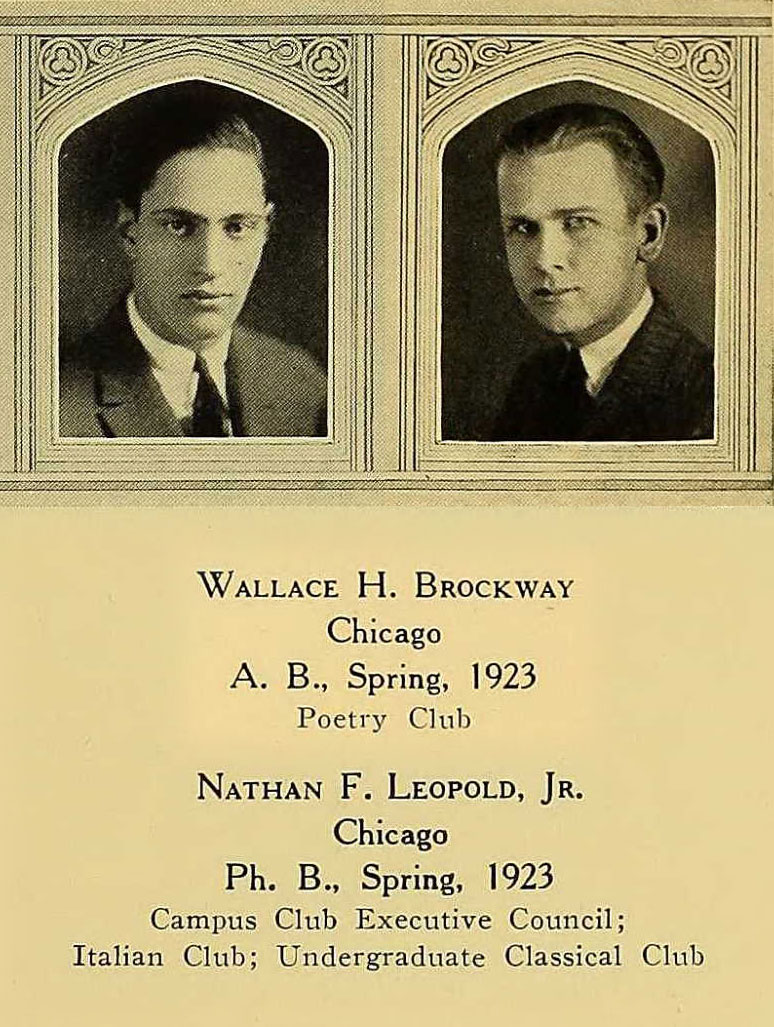
At age 16–17 Brockway had attended the Staunton Military Academy in Virginia, during the academic years of 1919–20 and 1920–21. Two decades later, in 1939 he gave a copy of one of his books to Major Roy Warren Wonson, the school’s headmaster, followed by a letter. (Again, Brockway appears to have been 16 rather than 14.)
I hope you were not too perplexed, some weeks ago to receive a copy of (Men and Music), by Wallace Brockway and Herbert Weinstock. If you were, permit me to jog your memory, and remind you of your kindness to a lonely 14-year-old boy, almost twenty years ago. That boy still remembers vividly your playing of Chopin and his pleasure at being allowed to sing a solo at Trinity [Episcopal] Church—I think it was Faure’s (Les Rameaux). At any rate, you fostered the boy’s love of music at a crucial moment of his life. In a sense, (Men of Music) constitutes a debt repaid, after many years.25
Brockway, W. H. is listed in the 1920 yearbook as a Private in both Company C and Band, listed only in Band in 1921.
To the 1920 yearbook Brockway (W. H. B.) contributed a disturbing short story, “The German,” narrated by a young soldier who, after a rocky start, becomes inseparable from a fellow soldier, one Max Lebbard. “When I think of him my thoughts conjure up a great pair of watery blue eyes.” The two are stationed in occupied Coblenz (Koblenz) when Lebbard steals away from camp, followed by the narrator. His destination is his parents’ house and his father’s contempt, “of treason to the fatherland.” Leaving the house, Max commits suicide.
The SMA newspaper The Kablegram carried the following notice in its tidbits column, February 14, 1920:
Brockway, W. H., has announced to the corps that he is engaged, and will probably be married this summer.26
I can’t help but wonder whether this was the result of an ultimatum as much as it appears to be Brockway’s declaration of normalcy. I did a half-hearted search of a marriage record: where to start? Chicago? Virginia? He was to be wed that summer, contradicted by his paean to his fictional comrade—unless W. H. B. was a typo, even intentional, and “The German” was written by a member of the graduating class, Elwyn H. Bishop, aka “Cherry,” who had been at the school for six years and was the yearbook’s military editor as well as a member of the Kablegram staff. That’s a lot of speculation.
Nevertheless Brockway’s parochial relationship with the headmaster should be considered. How did Wonson, and likely his wife Marie—she read Brockway’s letter publicly on a couple of occasions after receiving it in 1939—approach the “lonely 14-year-old boy” on the one hand, and the actual 16-year-old, with his fairly transparent literary allusions and an apparent love of music that brought him to the choir loft, if not the altar, of Trinity Church? What brought him to the school in the first place? And what, if anything, did he recognize in Martin Block, presumably half his age, when he met him on Fifth Avenue?
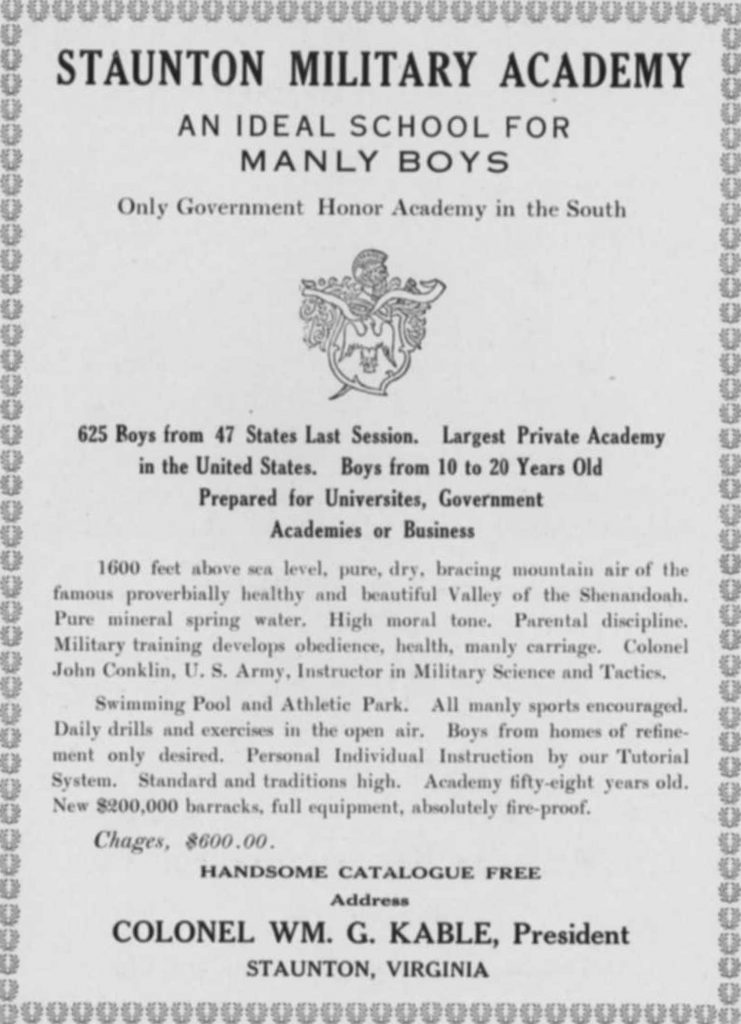
Leopold and Loeb
Four years later Brockway was a witness for the defense of Leopold and Loeb, but one of 16 such witnesses, which I suppose can be construed as “very few,” as Martin Block had put it, when compared with the 100 called by the prosecution. At the time, Brockway was just turning 21, and his testimony is revelatory yet reserved. He studied “arts and literature” at the university but didn’t obtain a degree. He’d known Nathan Leopold for about four years but didn’t consider him a friend. He respected Leopold’s intellect but only to a point.27
Cross examination:
Q You considered Leopold the finest man you ever came in contact with in the university, did you not?
A One of the best intellects; perhaps not the best, but one of the best.28
Simon and Schuster
Peter Schwed, in his profile of Simon and Schuster, includes this description, echoing van Loon above:
Wallace Brockway was almost certainly the storehouse of more erudition than could be believed, but his aspirations were never to be more than an ivory-tower editor. He was a walking encyclopedia and, being an expert in many fields, a regular contributor of Britannica articles.29
Brockway translated Andrea Majocchi’s Vita di chirurgo (Life of a Surgeon) for another publisher, issued in 1937.30
It can be noted that Nathan Leopold himself was a linguist, with fifteen tongues plus English under his belt. The fall of 1923 Leopold was considering a collaborative translation of Pietro Aretino (a taste here). His collaborator’s parents, upon learning of the project, spirited Leon Mandel II “packing to Europe.”31
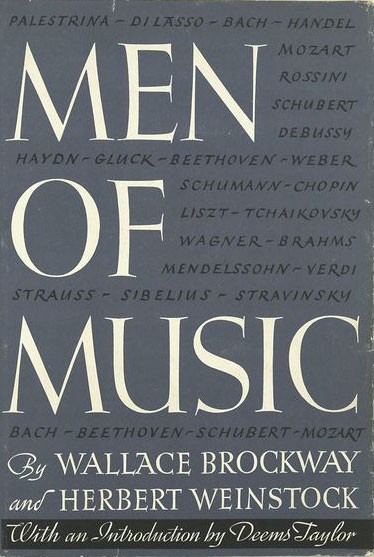
In 1939 Simon and Schuster published Brockway’s own bestselling Men of Music: Their Lives, Times, and Achievements, and in 1941 The Opera, a History of Its Creation and Performance: 1600–1941. Both of these were coauthored with Herbert Weinstock. And both men appear to have run with the Leopold and Loeb crowd, as explained by Schwed.
Wallace and his close friend Herbert Weinstock attended the University of Chicago when one of the most famous criminal cases of the century took place there, the murder of young Bobby Franks by Leopold and Loeb, and they knew all the protagonists of the affair very well. When Meyer Levin wrote his gripping novel Compulsion, based upon Clarence Darrow’s memorable defense of Leopold and Loeb, Wallace was a valuable source for Levin’s research, although it was a part of his life that Wallace would gladly have swept from his memory.32
In his own memory of Brockway’s account, Martin Block suggests no reticence in the telling.
A browse through Meyer Levin’s papers might shed light. Compulsion was published by Simon and Schuster in 1956. But, as Levin explains in his memoir, The Obsession, the idea for the book had come only after some probing by McGraw-Hill editor Robert Kuhn, who asked if the writer had “any Chicago ideas” since that city was Levin’s “background.” When he submitted the novel’s completed first half, McGraw-Hill rejected it. As did Random House’s Bennett Cerf, who had enjoyed Levin’s writing, but refused to consider the book based on the subject alone. Jack Goodman at Simon and Schuster liked it and accepted it for publication. Levin doesn’t mention Brockway’s involvement, so exactly when he contributed to the novel’s research would require its own investigation.33
In 1940, according to the federal census, Brockway and his coauthor Weinstock were renting together on Lexington Avenue south of 38th Street, with Weinstock having the day job of travel agent. The flat’s leaseholder was a 21-year-old underemployed copy editor named Herbert Winer who, as Bart Keith Winer, would coauthor two other books with Brockway, A Second Treasury of the World’s Great Letters (1941) and Homespun America: A Collection of Writings (1958), both issued by Simon and Schuster.
Winer was survived by his wife Shirley upon his death in 1989.34 By 1949 Weinstock was listed in the city directory as living with his “longtime companion” Ben Meiselman, who survived him upon his death in 1971, according to the New York Public Library.
Wallace Brockway died at age 69 on November 5, 1972 of a heart attack at his home on East 57th Street, survived only by his mother, Mrs. Ralph E. Simmons.35 His father, Louis Shaffner Brockway, had died in April of 1967 at age 86 in Los Angeles, not far from MacArthur Park and Loyola Law School, according to Social Security and voter registration records.
Secrets
The question of whether a horrific secret can be kept by multitudes was addressed a few years ago by Daniel Ellsberg, who notoriously did not keep his. He wrote in a memoir that “the fact is that the overwhelming majority of secrets do not leak to the American public.”36
If Wallace Brockway, via Martin Block, is correct about the motive for Leopold and Loeb killing Bobby Franks—a secret kept?—, would theirs not, in a perverse and fuzzy sense, be The Perfect Crime?
Notes
The Pageantry, the Spectacle
Back in the 1980s I was given tickets to a Southern California kitsch institution, Pageant of the Masters. The concept intrigued: an amphitheater stage filled with “ninety minutes of tableaux vivants (living pictures), incredibly faithful recreations of classical and contemporary works of art, with real people posing to look exactly like their counterparts in the original pieces,” as described on the event website. But the execution, meticulous as it was, underwhelmed. I guess I wanted more vivants in the tableaux, which occurred too infrequently. But it did occur in a sort of sideshow.
That sideshow was not the companion Fine Art Show, which we took in before the Pageant and from which Andrea and I bought a couple of hand-altered Polaroids that hang on our walls today. Allow me to digress…
Boom Boom Room
The Fine Art Show was conspicuous by the omission of skin: many of the artists appeared to be too well constrained by a bland family-friendly bubble-wrap envelope, but not so well contained that we couldn’t detect hints of riskier work. Hell, Laguna Beach (the Pageant/Show’s site) was home to the Boom Boom Room, which OC Weekly (formerly a sibling to Denver’s Westword via Voice Media Group) claims to have been “the oldest gay bar in the Western United States,” its host hotel, the Coast Inn, having opened in 1929, per the founders’ granddaughter’s timeline. Laguna even had its own chapter of the Mattachine Society beginning in the ’50s.
Continue reading “The Pageantry, the Spectacle”









